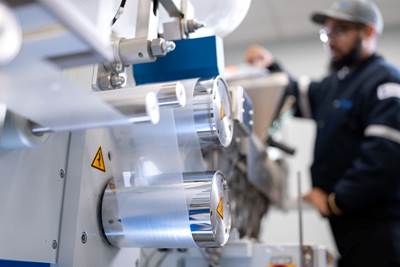WASTEWATER SAMPLING
We have a small plating line and batch wastewater treatment system that are captive to our manufacturing operation. For many years, the city has allowed us to perform grab sampling from a sampling port on the side of our batch treatment tank for our compliance sampling. During the city’s recent annual inspection, they stated that EPA is making them require us to install a sampling manhole outside of the plant; this manhole will also require a weir or flume to allow collection of flow proportional samples.
Q: We have a small plating line and batch wastewater treatment system that are captive to our manufacturing operation. For many years, the city has allowed us to perform grab sampling from a sampling port on the side of our batch treatment tank for our compliance sampling.
This is also the same location that they perform their own sampling. During the city’s recent annual inspection, they stated that EPA is making them require us to install a sampling manhole outside of the plant; this manhole will also require a weir or flume to allow collection of flow proportional samples.
Not only is this structure very expensive to install because of the location and depth of our existing sewer, but we will also need to either buy or rent an automatic sampler/flow meter in order to obtain the composite samples for metals. We believe this is an overkill for our small operation, but the city says it is an EPA requirement. We have always had a good relationship with the city, but this time they seemed edgy. Our compliance record is good; we have sporadic violations on one or two metals, but our follow-up samplings have always shown compliance. Your thoughts. S.H.
A: Just like the military, government bureaucracies always like to bump to blame up to a higher level. What has likely happened is that your city’s industrial pretreatment program was recently inspected either by your state or region EPA and the city was found to be deficient in its implementation. One of the specific issues is how the city has allowed you to sample your batch treatment tank; EPA likely contends that its does not provide for a representative sample since the wastewater quality can change as the wastewater leaves the batch treatment tank.
What the city is not telling you is that, based upon changes to USEPA general pretreatment regulations several years ago, the city has more flexibility on how it complies with the regulation’s sampling requirements. Under USEPA general pretreatment regulations, 40CFR403.12(g)(3), it reads “...24-hour composite samples must be obtained through flow-proportional composite sampling techniques, unless time-proportional composite sampling or grab sampling is authorized by the Control Authority. Where time-proportional composite sampling or grab sampling is authorized by the Control Authority, the samples must be representative of the Discharge and the decision to allow the alternative sampling must be documented in the Industrial User file for that facility or facilities.”
As you can see, this language gives the city much leeway. Even under the old regulations, the language read “flow proportional sampling, where feasible.”
With many wastewater sampling projects, there are two major issues that the government regulators want addressed: sample representativeness and access. Let me propose several options that you can evaluate for your particular situation, and if appropriate, use to approach the city.
If your flow is small enough and you have the room, consider a batch discharge tank. For this option, you pump from your batch treatment tank to your batch discharge tank each day. After stopping flow to the batch discharge tank, mix it (aeration, mixer, recirculation pump) for a period of time to achieve a homogenous volume, and at an agreed upon time with the city, discharge tank while it continues to be mixed. During the discharge, take your grab samples for all pollutants. The batch discharge tank pretty much guarantees a representative sample. Also, this option allows you to continue to grab sample—no automatic equipment needed.
A second alternative is time-proportional sampling of your batch treatment tank’s discharge. By installing a p-trap on the tank’s discharge and using an automatic time sampler, samples can automatically be taken every “x” minutes during discharge. I would use a maximum time period of 15 min or at least four samples, whichever produces the most samples.
A variation of the second alternative is to pump out of your batch treatment tank at a constant rate through a p-trap and use an automatic time sampler to take a sample every “x” minutes during discharge. Since there’s constant flow and time interval, this would be considered flow-proportional sampling.
A fourth alternative is to construct a small weir box containing a 22.5 or 30° v-notch weir; this small box, typically constructed of PVC or polypropylene, is fairly inexpensive and can be located inside your facility. You will still need to purchase or rent an automatic sampler/flow meter.
To address the access issue—that is, the city’s ability to obtain a sample without entering your plant— I would propose a large cleanout be installed on the sewer from the plant. This is much less expensive than a manhole and gives the city access to obtain a grab sample for a quick check of your wastewater quality.
If your city still insists that they require an outside sampling manhole, I strongly recommend that you use a flume instead of a weir as your primary flow device. Over time, solids will collect behind the weir, and these solids contain regulated metals. Even if you sample downstream of the weir, a flow surge can stir up these solids, causing them to suspend and be sampled. I have participated in numerous compliance meetings with cities on this very issue. If there is sufficient slope in your existing sewer pipe, my first recommendation is to utilize a 1-inch Parshall flume; for a shallow slope pipe, my second recommendation is to utilize a 4-inch Palmer-Bowlus flume. These are standard fiberglass-constructed flumes available from a number of fabricators around the country.
I hope your past good relationship with the city helps them be reasonable in addressing your situation. Just keep in mind their need to satisfy the key issues of sample representativeness and access.
Related Content
Explore Cleaning Chemistry, Metal Finishing Applications and Wastewater Treatment Solutions
Hubbard-Hall Celebrating 175 years of excellence, Hubbard-Hall presents chemistry and equipment.
Read MoreNASF/AESF Foundation Research Project #120: Electrochemical Destruction of Perfluorooctanesulfonate in Electroplating Wastewaters - April 2022-March 2023
This NASF-AESF Foundation research project report covers project work from April 2022 to March 2023 at the University of Illinois at Chicago. The overall objective of this work is to utilize a cost-effective reactive electrochemical membrane (REM) for the removal of PFAS from synthetic electroplating wastewater. Initial results for the oxidation of PFOA with three different catalysts are discussed.
Read MoreNASF/AESF Foundation Research Project #122: Electrochemical Approaches to Treatment of PFAS in Plating Wastewater - 12th Quarterly Report
This NASF-AESF Foundation research project report covers the 12th quarter of project work (October – December 2023) at the University of Georgia. In our previous report, we described our work on performance and effect of surface fluorinated Ti4O7 anodes on PFAS degradation in reactive electrochemical membrane (REM) mode. This quarter, our experiments involved utilizing porous Ti4O7 plates serving both as anodes and membranes. Tests compared pristine and F-18.6 Ti4O7 anodes at current densities of 10 mA/cm2 and 40 mA/cm2. This 12th quarterly report discusses the mechanisms of the effects on EO performance by anode surface fluorination.
Read MoreNASF/AESF Foundation Research Project #120: Electrochemical Destruction of Perfluorooctanesulfonate in Electroplating Wastewaters – January – December 2023
This NASF-AESF Foundation research project report covers quarterly reporting for the year 2023 at the University of Illinois at Chicago. The objective of this work is to utilize a cost-effective reactive electrochemical membrane (REM) for the removal of PFAS from synthetic electroplating wastewater. Discussed here are the oxidation of PFOA with three different catalysts, development of a method for detecting PFAS, as well as work on 6:2-fluorotelomersulfonic acid (6:2 FTS) and electrodeposited bismuth/tin oxide catalysts.
Read MoreRead Next
A ‘Clean’ Agenda Offers Unique Presentations in Chicago
The 2024 Parts Cleaning Conference, co-located with the International Manufacturing Technology Show, includes presentations by several speakers who are new to the conference and topics that have not been covered in past editions of this event.
Read MoreDelivering Increased Benefits to Greenhouse Films
Baystar's Borstar technology is helping customers deliver better, more reliable production methods to greenhouse agriculture.
Read MoreEducation Bringing Cleaning to Machining
Debuting new speakers and cleaning technology content during this half-day workshop co-located with IMTS 2024.
Read More









.jpg;maxWidth=300;quality=90)














